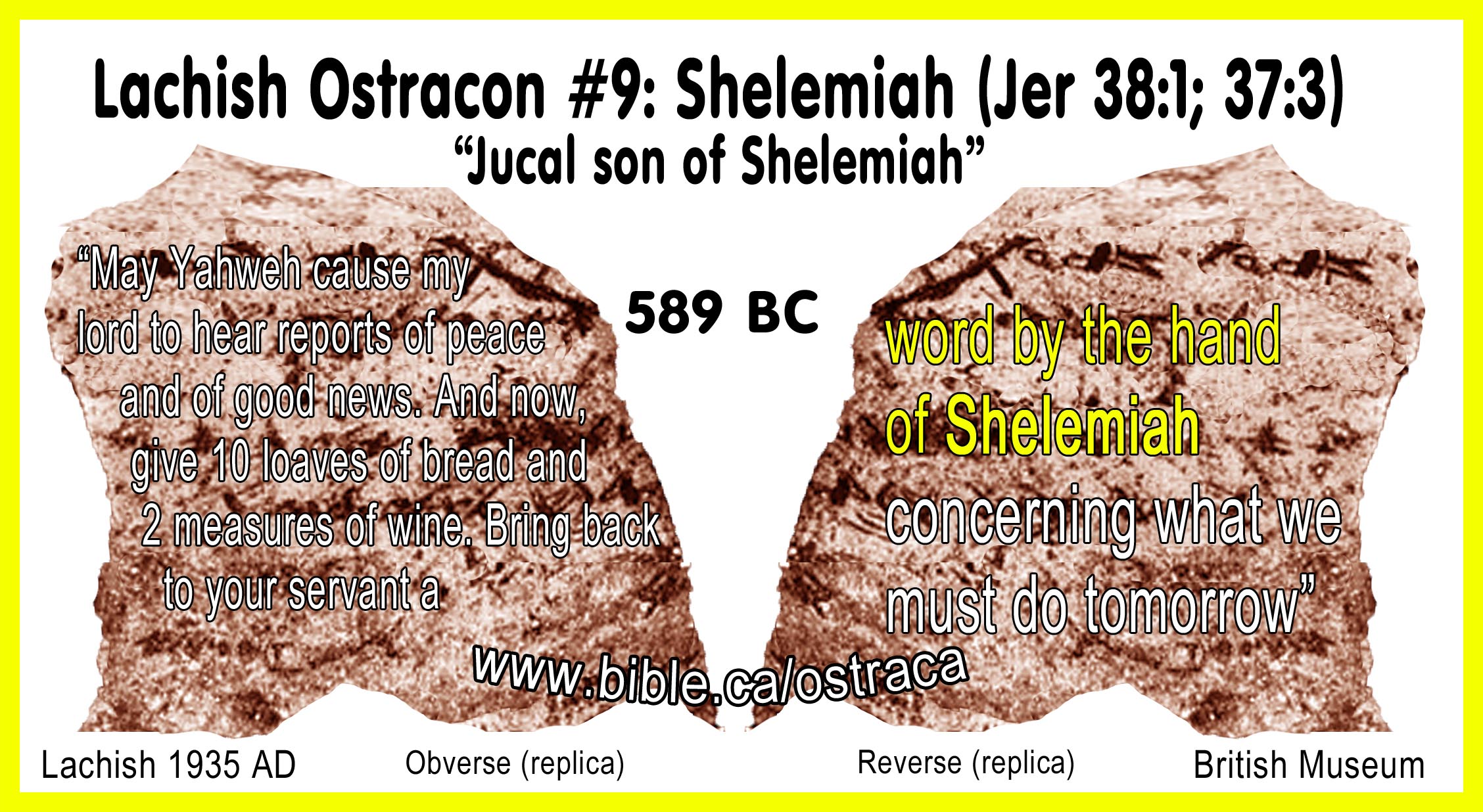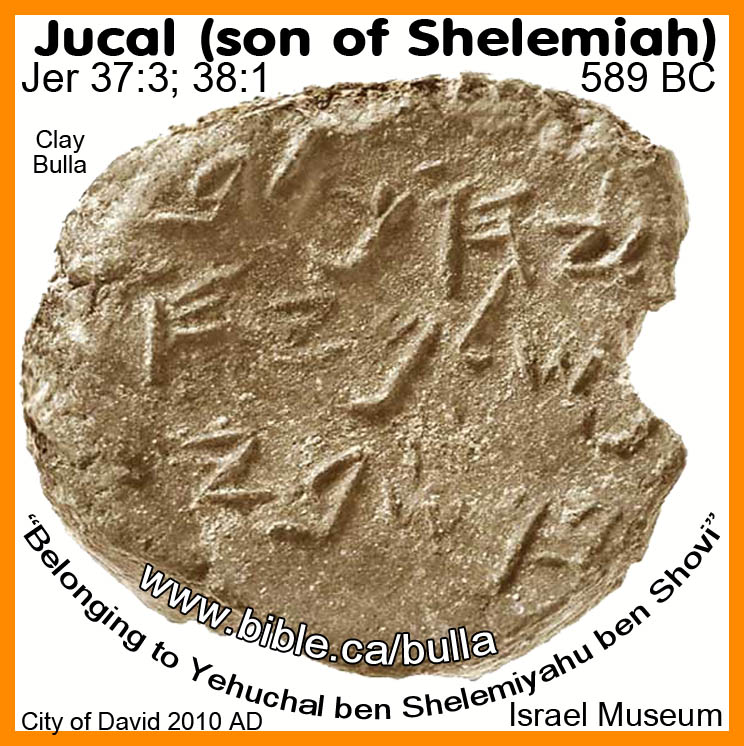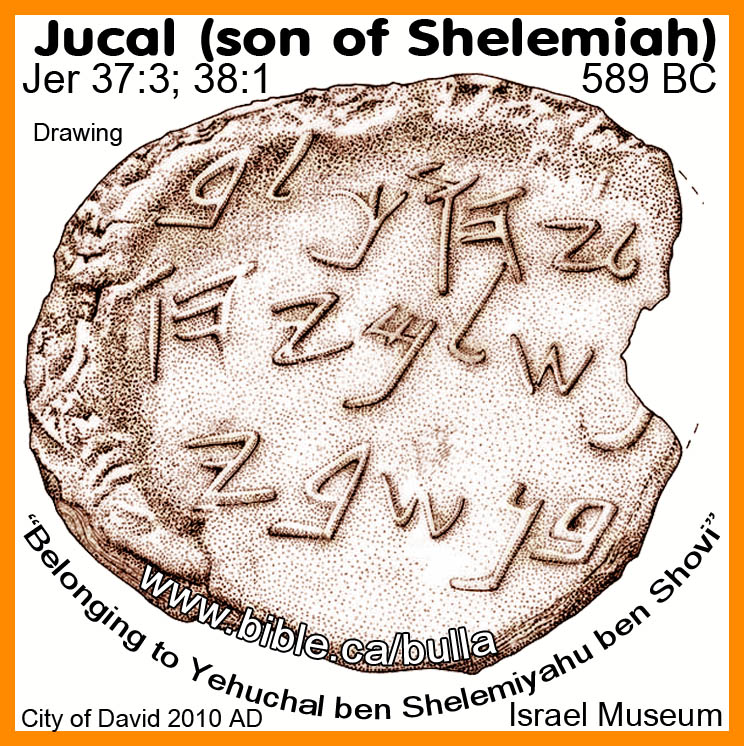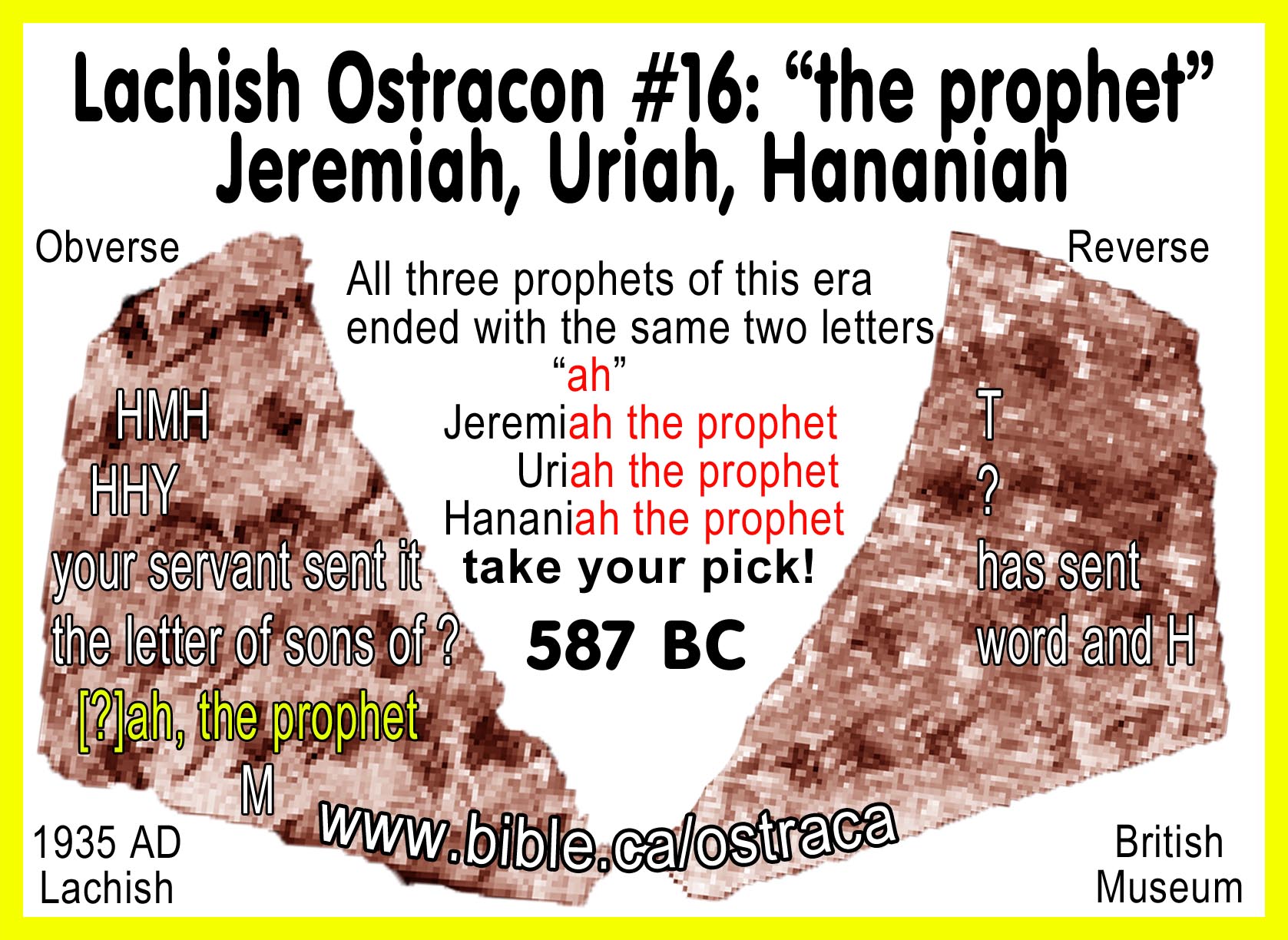Ostraca, Tablets and Inscriptions of the Bible
|
Lachish Letters |
Discovered in 1935 AD from an official archeological dig these ostraca were the written records of communications between the city of Lachish and the king in Jerusalem at the time Nebuchadnezzar attacked Jerusalem 605-587 BC. |
|
|
Lachish Ostraca collection |
|
|
|
||
Introduction:
- Discovered in 1935 AD from an official archeological dig these ostraca were the written records of communications between the city of Lachish and the king in Jerusalem at the time Nebuchadnezzar attacked Jerusalem 605-587 BC.
- "Some thirty-six inscriptions have been discovered at Tell ed-Duwêr/Tel Lachish, including Proto-Canaanite inscriptions, inscribed seals and weights, several Egyptian inscriptions, and an Aramaic inscription on a Persian-period altar (for a recent overview with bibliography, see Pardee 1997c). The so-called “Lachish Letters,” nineteen inscribed ostraca discovered in 1935 and 1938 and published rapidly by Torczyner (1938, 1940) are the best known of these texts, for several are relatively long and well preserved and of great interest from a variety of perspectives. At least twelve of these nineteen texts are letters, of which the six best-preserved are translated here; one is a list of names; several are too poorly preserved for identification. The letters are at least partially homogeneous, for five of the ostraca are sherds from the same vessel (L. Harding apud Torczyner 1938:184). Whether this means that the documents are drafts of letters written on the site and sent elsewhere (Yadin 1981) is open to debate (Rainey 1987; Parker 1994). They are generally dated to the period before the fall of Judah (586 bce), perhaps in 589, and they provide glimpses of the workings of the royal administration, primarily military, in this period shortly before the Babylonian exile. Because they are letters, they also give precious insights into the personal aspects of these administrative workings. From the perspective of the history of discovery, the Lachish inscriptions were the first cohesive body of original texts from the pre-exilic period in Hebrew and they were therefore very important in providing data on all aspects of the Hebrew of that period: palaeography, grammar, rhetoric, and, specifically, epistolary usages." (Context of Scripture, Lachish Letters, Dennis Pardee, COS 3.42, p78, 2002 AD)
- "These ostraca were discovered in the ruins of the latest Israelite occupation at Tell ed-Duweir in southern Palestine, which unquestionably represents biblical Lachish. The first 18 were found by the late J. L. Starkey in 1935; three more (making 21 in all) were added during a supplementary campaign in 1938. Most of the ostraca were letters, while others were lists of names, etc., but only a third of the documents are preserved well enough to be reasonably intelligible throughout. Nearly all of the ostraca come from the latest occupation level of the Israelite gate-tower, and they are generally placed immediately before the beginning of the Chaldean siege of Lachish, perhaps in the autumn of 589 (or 588) b.c. Since they form the only known corpus of documents in classical Hebrew prose, they have unusual philological significance, quite aside from the light which they shed on the time of Jeremiah." (The Lachish Ostraca, ANET 321–322)
- "Several thorny issues relating to the interpretation of these letters remain unresolved. Without entering into the debates, I simply state the assumptions made here: (1) Tell ed-Duweir is ancient Lachish; (2) these ostraca are copies or drafts of letters sent from (not to) Lachish (see Yadin 1984); (3) the addressee, Yaush, named only in nos. 61, 62, and 64, is the intended recipent of most or all of the other letters; (4) Yaush is probably located in Jerusalem; (5) Hoshayahu, named as the sender of no. 62, is the author of the entire collection. These assumptions provide a coherent framework in which to read the letters." (Ancient Aramaic and Hebrew Letters: Translations. J. M. Lindenberger, Page 117, 2003)
|
Lachish
Ostracon #2: YHWH |
|
|
Lachish Ostracon #2: YHWH Note: Lachish ostraca 2,6,7,8,18 from same pottery vessel , written by same scribe at the same time in 589 BC.
Inscription on pottery shard: “To my lord Joash1: May Yahweh give you good news at this very time. Who is your servant [but] a dog2 that my lord should remember his servant? May Yahweh give my lord first knowledge of anything you do not already know.” 1: Unknown commander, Not king Joash 2: 2 Sam 9:8; 2 Ki 8:13, Lachish Ostracon 6, Amarna Tablets
1935 AD Lachish: British Museum Date of ostracon: 589 BC |
|
|
Lachish Ostracon #3: YHWH, Hoshaiah, Uriah, Elnathan: Jer 26:20-23 |
|
|
Lachish Ostracon #3: YHWH, Hoshaiah, Uriah, Elnathan: Jer 26:20-23 This amazing ostracon directly relates to a story in the book of Jeremiah! Both prophets Jeremiah and Uriah ordered the Jews to surrender to Nebuchadnezzar and warned about fleeing from Nebuchadnezzar to Egypt. "Uriah prophesied against Judah in words exactly like Jeremiah. King Jehoiakim sought to kill him but Uriah fled to Egypt. Jehoiakim sent Elnathan son of Achbor and men with him to Egypt, returned Uriah Jehoiakim, who killed him" (Jeremiah 26:20-23) |
|
|
Jeremiah Warnings to surrender to the Babylonians or die: 605 BC: Jeremiah 45:5 (Jehoiakim) 595 BC: Jeremiah 27:12-3; 16-17 (Zedekiah) 589 BC: Jeremiah 38:2, 17-18 (Zedekiah) 587 BC: Jeremiah 21:9 (Zedekiah) 1. "‘But you, are you seeking great things for yourself? Do not seek them; for behold, I am going to bring disaster on all flesh,’ declares the Lord, ‘but I will give your life to you as booty in all the places where you may go.’ ”" (Jeremiah 45:5: 605 BC) 2. "I spoke words like all these to Zedekiah king of Judah, saying, “Bring your necks under the yoke of the king of Babylon and serve him and his people, and live! “Why will you die, you and your people, by the sword, famine and pestilence, as the Lord has spoken to that nation which will not serve the king of Babylon?" (Jeremiah 27:12–13: 595 BC) 3. "Then I spoke to the priests and to all this people, saying, “Thus says the Lord: Do not listen to the words of your [false] prophets who prophesy to you, saying, ‘Behold, the vessels of the Lord’s house will now shortly be brought again from Babylon’; for they are prophesying a lie to you. “Do not listen to them; serve the king of Babylon, and live! Why should this city become a ruin?" (Jeremiah 27:16–17: 595 BC) 4. "Thus says the Lord, ‘He who stays in this city will die by the sword and by famine and by pestilence, but he who goes out to the Chaldeans will live and have his own life as booty and stay alive.’" (Jeremiah 38:2: 589 BC) 5. "Then Jeremiah said to Zedekiah, “Thus says the Lord God of hosts, the God of Israel, ‘If you will indeed go out to the officers of the king of Babylon, then you will live, this city will not be burned with fire, and you and your household will survive. ‘But if you will not go out to the officers of the king of Babylon, then this city will be given over to the hand of the Chaldeans; and they will burn it with fire, and you yourself will not escape from their hand.’ ”" (Jeremiah 38:17–18: 589 BC) 6. "He who dwells in this city will die by the sword and by famine and by pestilence; but he who goes out and falls away to the Chaldeans who are besieging you will live, and he will have his own life as booty." (Jeremiah 21:9: 587 BC) Warnings about fleeing Nebuchadnezzar to Egypt: 609 BC Uriah, Hoshaiah (ostracon 3): Jer 26:20-23 586 BC Jeremiah, Hoshaiah's son Jezaniah: Jer 42:1; 43:2
Inscription on pottery shard: “Your servant Hoshaiah1 sent (this letter) to report to my lord Joash2. May Yahweh cause my lord to hear a report of peace and a report of good news. And now, open the ear of your servant with respect to the letter which you sent to your servant last evening, for the heart of your servant has been ill since you sent (it) to your servant, and because my lord said, "You did not understand it-- call a scribe!" By the life of YHWH no man has ever dared to try to read a letter to me! Moreover, any letter that comes to me, if I have read it, I can afterwards [re]count it to the last detail! And it was told to your servant, saying, "The commander of the army, Coniah, son of Elnatan, has gone down to go to Egypt," and as for Hodavyahu, son of Ahijah and his men: he (commander Coniah) sent (orders) to take (them) from that (location-Egypt). And as for the letter of Tobiah, the servant of the king, which came to Shallum, son of YD from the prophet3, saying "Beware!"--your servant has (already) sent it to my lord." 1: Hoshaiah here in 587 BC His son in 580:Jer 42:1;43:2 2: Commander, not king Joash 3: Uriah or Jeremiah both preached “beware” to the Jehoiakim.
1935 AD Lachish: British Museum Date of ostracon: 609 BC |
|
|
Lachish Ostracon #4:YHWH, Fire Signals of Azekah, Jer 34:6-7; 6:1 |
|
|
Lachish Ostracon #4: YHWH, Fire Signals of Azekah, Jer 34:6-7; 6:1 Fire signals and passenger pigeons were the way ancient cultures communicated with each other. Jer 6:1 actually mentions the use of fire signals: "Flee for safety, O sons of Benjamin, From the midst of Jerusalem! Now blow a trumpet in Tekoa And raise a [fire] signal over Beth-haccerem; For evil looks down from the north, And a great destruction." (Jeremiah 6:1) |
|
|
"The fire signals of Azekah are no more" Another amazing confirmation that the Bible is always a 100% accurate record of history! Both Azekah and Lachish were high hill tops in southern Judah and used like modern "communication relay towers" to relay messages back to Jerusalem using smoke signals from hilltop to hill top. Here is direct confirmation from the Bible story on a text written on a piece of broken pottery. When Nebuchadnezzar attacked Judah, he conquered both the cities of Lachish and Azekah. The ostraca is an amazing snapshot in time at the very moment after Nebuchadnezzar destroyed Azekah as he marched 20 km towards Lachish. Those in Lachish send a message to Jerusalem for help and notice they inform Zedekiah (who is not named in the message) that Nebuchadnezzar has captured Azekah noting "the fire signals of Azekah are no more".
"Then Jeremiah the prophet spoke all these words to Zedekiah king of Judah in Jerusalem when the army of the king of Babylon was fighting against Jerusalem and against all the remaining cities of Judah, that is, Lachish and Azekah, for they alone remained as fortified cities among the cities of Judah." (Jeremiah 34:6–7)
Inscription on pottery shard: “May Yahweh cause my lord to hear reports of good news this very day. And now, according to all that my lord sent thus your servant has done. I have written upon the tablet according to all that [you] have sent to me. And with respect to what my lord sent concerning the matter of Beth-Harapid, there is no man there. As for Semakyahu, Shemayahu has seized him and taken him up to the city. Your servant cannot send the witness there today; rather, it is during the morning tour that [he will come (to you)]. Then it will be known that we are watching the (fire)-signals of Lachish1 according to the code which my lord gave us, for we cannot see Azekah1. 1: Azekah is 20 km from Lachish, both mountaintops
1935 AD Lachish: British Museum Date of ostracon: 587 BC |
|
|
Lachish
Ostracon #6: YHWH, you are
weakening the hands of the people |
|
|
Note: Lachish ostraca 2,6,7,8,18 all from same pottery vessel and written by same scribe at the same time (589 BC). |
Lachish Ostracon #6: YHWH, "weakened hands" Another amazing confirmation of a Bible story in Jeremiah written on pottery sherds. Jeremiah's message was clear: surrender to Nebuchadnezzar or you will die. “The officials said to Zedekiah, ‘kill Jeremiah, for he is weakening the hands of the soldiers who are left in this city, and the hands of all the people, by speaking such words to them. For this man is not seeking the welfare of this people, but their harm.’” (Jeremiah 38:4-6)
Inscription on pottery shard: “To my lord, Joash1. May Yahweh show my lord this season one of peace. Who is your servant, a dog2, that my lord has sent me the letter of the king and the letters of the princes saying: "Read!" Now, behold, the words of the princes are not good, weakening your hands and to make limp the hands of the men who are informed about. As for me, my lord, write them saying, “Why do you act like this, even in Jerusalem - behold, even against the king and against his house you have done this thing?” And as Yahweh your God lives, that since your servant read the letters, your servant has not had a moment’s peace." 1: Unknown commander, not king Joash 2: 2 Sam 9:8; 2 Ki 8:13, Lachish Ostracon 2, Amarna Tablets
1935 AD Lachish: Rockerfeller Museum Date of ostracon: 598 BC |
|
Lachish Ostracon #9: Shelemiah (Jer 38:1; 37:3) “Jucal son of Shelemiah” |
||
|
Lachish Ostracon #9: Shelemiah (Jer 38:1; 37:3) Jucal son of Shelemiah
Inscription on pottery shard: “May Yahweh cause my lord to hear reports of peace and of good news. And now, give 10 loaves of bread and 2 measures of wine. Bring back to your servant a word by the hand of Shelemiah concerning what we must do tomorrow” 1935 AD Lachish: British Museum Date of ostracon: 587 BC |
||
|
Bulla of Jucal son of Shelamiah For a full discussion of the bulla of Shelamiah click here In one of the most spectacular archeological finds, Eilat Mazar found two clay seals naming two different men named in A SINGLE BIBLE VERSE!!! What is more spectacular, is that Eilat Mazar found the two clay bullae in the same archeological excavation two years apart (2008, 2010) only a few meters from each other! Both names on the two seals are found in one Bible verse: "Now Shephatiah the son of Mattan, and Gedaliah the son of Pashhur, and Jucal the son of Shelemiah, and Pashhur the son of Malchijah heard the words that Jeremiah was speaking to all the people, saying," (Jeremiah 38:1) These clay seals are both featured in the Israeli Museum in Israel. |
||
|
Lachish Ostracon #16: “the prophet” Jeremiah, Uriah, Hananiah |
|
|
Lachish Ostracon #16: “the prophet” Jeremiah, Uriah, Hananiah
Inscription on pottery shard:
"…your servant sent it the letter of sons of ? [?]ah, the prophet…"
|
|
|
Jeremiah the prophet! Only the last two letters "AH" of the prophet's name survived on the ostraca. All three prophets of this era ended with the same two letters “?ah”. Considering the high profile role Jeremiah had during this entire period, its seems likely that this is indeed Jeremiah being referred to on this ostraca. We cannot be sure which one it is, but it's great to have so many choices! Take your pick: Jeremiah the prophet Uriah the prophet Hananiah the prophet 1935 AD Lachish: British Museum Date of ostracon: 587 BC |
|
By Steve Rudd: Contact the author for comments, input or corrections.









